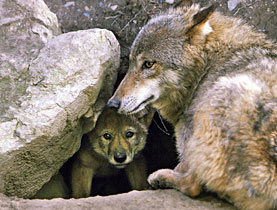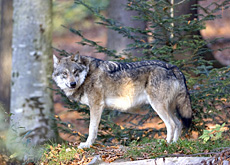Zoos take aim at “big bad wolf” myth

Wolves, which have returned to Switzerland after more than a century's absence, have had a bad press, especially over their attacks on sheep.
But experts say that the wolf is still largely misunderstood and – unlike in stories – poses no danger to humans. A special project has been launched to counter the public’s fears.
Wolves were driven to extinction in Switzerland in the 19th century. They started to reappear in small numbers in 1995, having wandered in from neighbouring France, Italy and Austria.
However, their periodic attacks on livestock caused concern. Although a protected species, there have been cases of wolves being shot.
The Association of Swiss Zoos is convinced that man and wolf can live together peacefully. It launched a project on August 26 to help increase understanding of the animals.
“People are still afraid because of the fairy tales they know,” said Alex Rübel, director of Zurich Zoo, one of the four organisations involved in the “Theatre with Wolves” scheme.
“Wolves don’t normally attack humans. They are actually very shy and hide and only very few people have seen a wolf,” he told swissinfo at a media conference at the Langenberg Wildlife Park near Zurich.
The Wildlife Park, itself home to a large population of captive wolves, Basel Zoo and the Landscape and Animal Park Goldau in central Switzerland are the other three locations taking part.
Lone wolves
At present there are only around seven wolves in the wild in Switzerland. Rübel explained that when wolves first come into a new area – often young, lone males – they sometimes kill sheep.
“We know that once they get used to staying here, around three quarters of their diet is wild animals, like deer or marmots,” he said.
“They live high up in the mountains and don’t attack sheep if they have other things to eat and if the sheep are protected by guard dogs.”
Graubünden, in eastern Switzerland, is one of the areas – along with Valais in the French speaking part of the country – which has been most affected by the wolf’s return.
In fact, as gamekeeper Kasper Sax explained at the media conference, his Surselva region was taken by surprise when wolf suspicions were raised in 1997.
“The first indications were tracks and then sporadic sightings but people weren’t used to the idea of a wolf, so sometimes they were thought to be large dogs,” he told swissinfo.
“Then there were attacks on domestic animals, mostly on sheep and then on weak wild animals, and because of these criteria we came to the conclusion that a wolf was in the region.”
Co-existence
This was confirmed by a DNA test in 2002. The wolf is still in the area, but Sax says that in the past few years attacks have stopped as farmers now use guard dogs to protect their livestock and herd sheep into pens at night.
In addition, the wildlife population is healthier because the weaker animals are picked off, added Sax.
A change could come if another animal was to appear, especially if it were a female, said the gamekeeper. “But we can’t know this in advance,” he said.
Rübel said that another aim of the project was to help inform farmers how to best protect their animals. This includes collecting money to help them buy special livestock guard dogs.
But the Zurich Zoo director is aware that it will take time for farmers to learn to live with wolves and shepherds get used to the guard dogs.
He knows that there is some work to be done among the population too. But he is hoping increased information and the instigation of a special theatre competition for schools on the theme of wolves will help counter the animals’ bad reputation.
“In Italy and France people have been living for a long time with the wolves and it works very well. That’s what we’re trying to install here to,” Rübel said.
swissinfo, Isobel Leybold-Johnson at the Langenberg Wildlife Park
Wolves gained “strictly protected” status in Europe under an international agreement after being driven to extinction in the 19th century, largely by hunting and the expansion of human settlements.
They started to return to Switzerland around ten years ago from neighbouring countries and have begun colonising again.
Switzerland is said to be the country with highest culling levels in Europe. The penalty for illegally killing a wolf is up to one year in prison and a fine.
In March the authorities stepped up protection of wolves, saying that the animals should only be hunted down in areas where they have attacked a guarded flock of sheep, but not in a habitat where they are present during mating.
The “Theatre with Wolves” project is taking place at four locations: the zoos in Basel and Zurich, the Langenberg Wildlife Park at Langnau am Albis near Zurich, and the Landscape and Animal Park Goldau in central Switzerland.
Each will be, over the next year, informing visitors about the life and habits of wolves.
Schools will also be targeted and can take part in a special competition to come up with a play or performance piece about wolves. The winners will be chosen by a special jury and will be able to perform their work in theatres near the zoos.
A further measure involves supporting the Swiss Association for Developing Agriculture and Rural Ideas (Agridea) in its livestock guard dog project for farmers.

In compliance with the JTI standards
More: SWI swissinfo.ch certified by the Journalism Trust Initiative


You can find an overview of ongoing debates with our journalists here. Please join us!
If you want to start a conversation about a topic raised in this article or want to report factual errors, email us at english@swissinfo.ch.